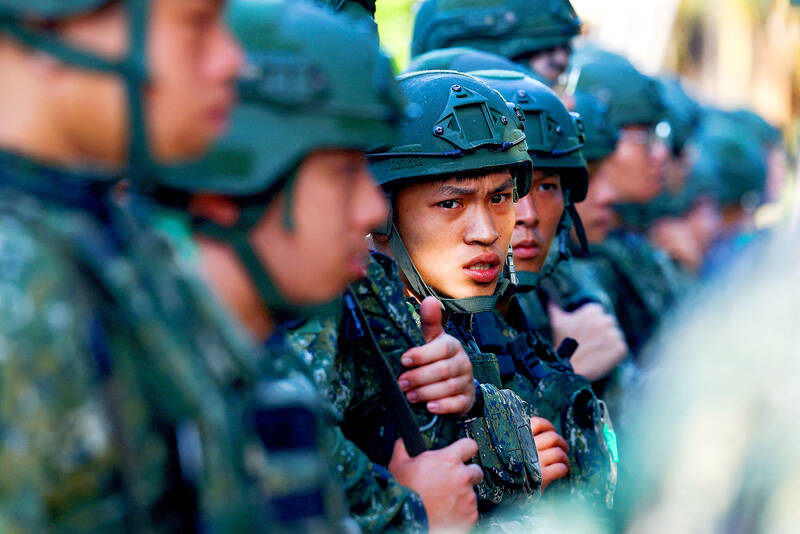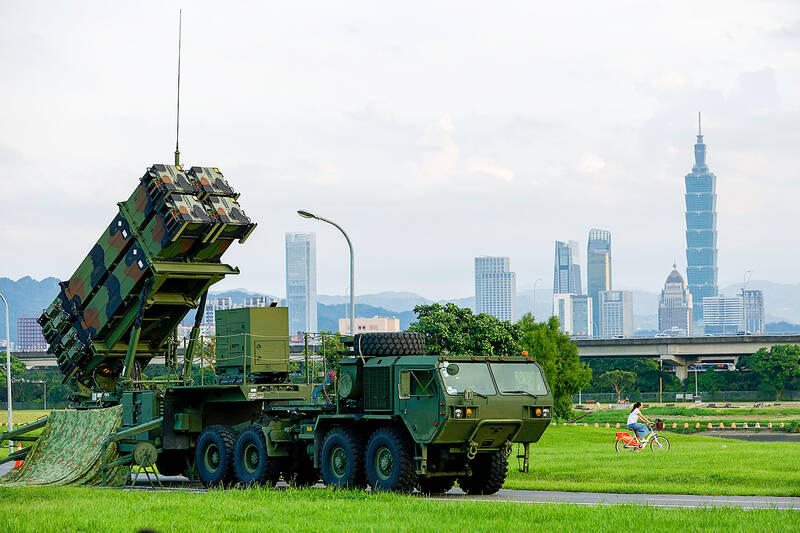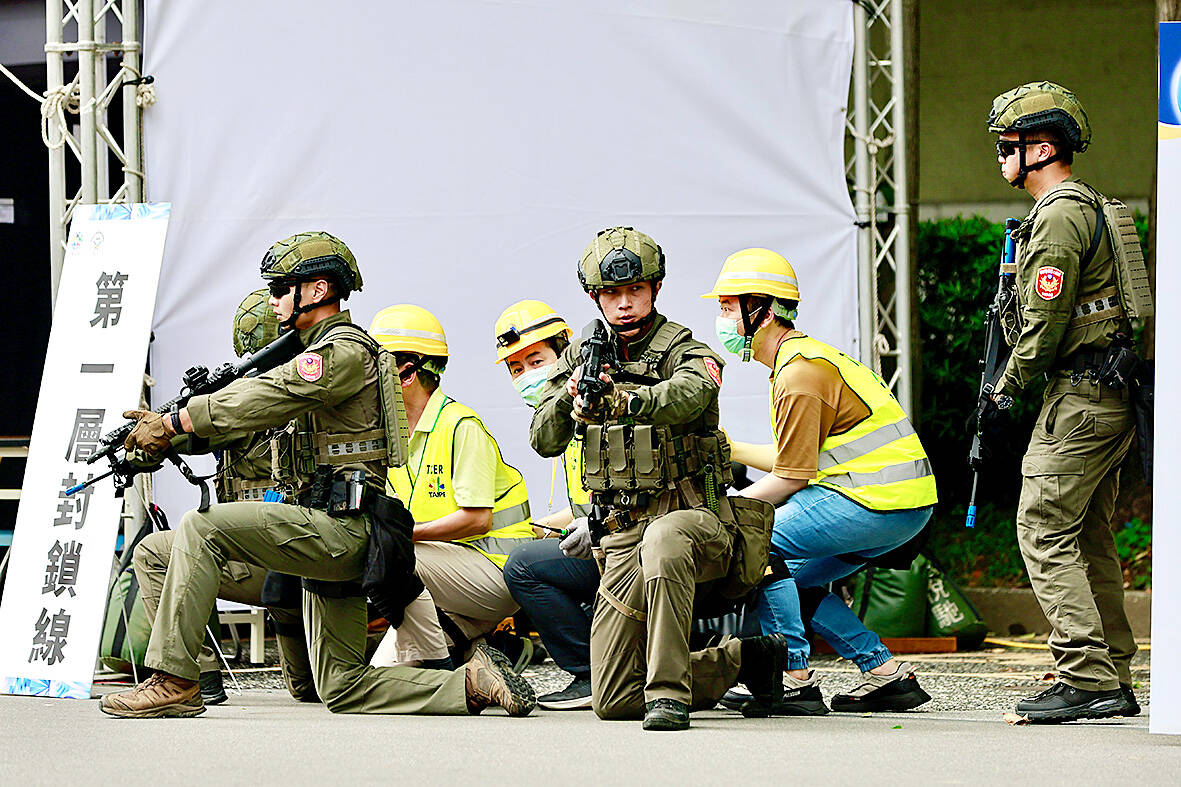“Taiwanese increasingly reluctant to give their lives to defend the island,” trumpeted a South China Morning Post (SCMP) headline last week. The survey asked whether people should be prepared to pay any price — including death — to protect Taiwan and prevent “reunification.”
“The poll found that 52.2 percent of those questioned were unwilling to do so — an 8.4-point rise compared with a similar survey carried out two years ago — while 40.8 percent were willing, down four points on the previous survey,” the article said.
Treated as anti-Taiwan propaganda, the piece was sent around by the usual pro-China suspects on social media. “See!” they cried, “things are changing!” That was actually true. As veteran Taiwan military analyst Kitsch Liao (廖彥棻) pointed out on Twitter, willingness to fight had actually risen 12 percent among 20-29 year olds since 2023.

Photo: Reuters
The willingness decline in that poll had largely taken place among 30-39 year olds, he observed, attributing that to the fact that reserve duty ends at 40.
“It is unfortunate this poll asking whether people are willing to ‘fight to the death’ is only carried out every 2 years, as there is no way to separate the significant effect of [Democratic Progressive Party] DPP’s recent disastrous recall election from the underlying sentiment the poll [intends] to gauge,” Liao said.
TAIWANESE IDENTITY

Photo: EPA
One could also look at the National Chengchi University’s Election Center Taiwanese identity poll, which shows that the “Taiwanese-only” identity accounts for over 60 percent of the population, and has been steady at around that figure for several years. In fact, the “Taiwanese-Chinese” identity is in decline, from 38.2 percent in 2018, to just 30.5 percent now. The “Chinese-only” identity has been moribund for decades. Yep, things are changing: the Taiwanese are steadily becoming even more Taiwanese.
Another perspective on the “willingness to fight” findings is provided by academic work exploring public support for the use of force. The constant attacks on US backing for Taiwan from the pro-China parties and their supporters is quite logical, given how weak states behave when forced to confront more powerful states.
A classic work from naval analyst Eric Labs on how weak states behave when backed by a great power notes that when weaker states are supported by great powers, they act more aggressively, “strengthening the weak state’s tendency to balance.” However, Labs writes, the most preferred choice of weak states is non-alignment, if they can get it.

Photo: EPA
Given this, it is easy to understand the logic of the pro-People’s Republic of China (PRC) propaganda attacks in local politics. They appeal this temptation, arguing for a “neutral” position. A variation of that position, which does not name “neutrality” as the preferred choice, is to contend that Taiwan is “between” the US and the PRC.
It should always be recalled in these debates that Taiwan is in the space where it is because the PRC has put it there with its demands for submission and annexation. Ironically, if the PRC did not threaten Taiwan, Taiwanese would be happy to move closer to it.
The second choice of weak states is to “bandwagon” with the powerful threat, joining or appeasing it. Note that this too is part of the propaganda suite of local pro-China forces (“Join China, it is rich and rising!”), and is in fact the choice the Chinese Nationalist Party (KMT) made beginning around 2000. Hence, one reason that pro-China propaganda has so much appeal is that it tracks the most preferred choices of small states in the face of threats from Great Powers. Balancing the Great Power threat by aligning with another Great Power, which is what Taiwan is actually doing, is a less-preferred choice, more difficult to justify.

Photo: EPA
CONFLICTING PERCEPTIONS
A robust piece last year in the International Political Science Review on the willingness to use force identifies two excellent reasons for the conflicting and highly variable results for polling on “willingness to fight” in Taiwan. First, the actual questions and conditions vary widely across polling bodies. Second, they seldom clearly specify conditions, such as “Taiwan declares independence” or “the US does not support Taiwan.”
It should be added that many of these polls do not follow the issue over a long period of time, since they are intended as instant propaganda for one side or the other.
The study found that when respondents considered their military training useful (a huge “if” for local conscripts), they were more willing to fight. They also asked their sample about US intervention, finding logically that if the US intervened, there would be greater willingness to fight. Finally, they asked about Taiwan independence, but found no significant effect. The public will fight if the PRC invades, whether or not the island has “declared independence” (something always discussed in the media, but never clearly defined).
They also looked at casualty tolerance: are people still willing to fight when casualties rise? Again, the survey showed US intervention was critical. People were more willing to tolerate casualties if the US backed Taiwan.
Another paper last year in Issues & Studies used data from the Taiwan National Security Survey (TNSS), sponsored by Duke University in the US, and conducted by National Chengchi University.
That survey looks at other aspects of willingness to fight, such as “defeatist” attitudes and whether people will fight. Defeatist attitudes, in which participants answered an open-ended question (run away, surrender, do nothing, etc) on what they would do if war began, fell from over 80 percent in 2016 to 43.3 percent in 2022.
“TNSS surveys since 2016 have shown a steady increase in support for military action and a willingness to defend the nation,” they observe.
TNSS surveys also show that large majorities feel that other Taiwanese would fight, a feeling that increases individual willingness to fight.
“We can conclude that the military threat from China ultimately led to substantial increases in Taiwan’s public support for resistance,” the authors write.
They call for greater cultivation of public support for defending Taiwan, which is the basis for armed resistance to annexation.
The overall trend is clear: over the last decade, Taiwanese have grown more willing to fight the PRC if it attacks Taiwan. Keep this trend in mind as polls post wildly varying numbers showing spikes in one direction or another, and media organs like SCMP cherry pick the data from them.
In any case, the constantly shifting polls on willingness to fight will actually mean very little once bombs start falling and loved ones start dying. The danger lies in authoritarians believing their own propaganda and making war based on it, and in locals hearing this propaganda and believing it.
That is why it is constantly repeated, and that is why it must be constantly refuted.
Notes from Central Taiwan is a column written by long-term resident Michael Turton, who provides incisive commentary informed by three decades of living in and writing about his adoptive country. The views expressed here are his own.

Exceptions to the rule are sometimes revealing. For a brief few years, there was an emerging ideological split between the Democratic Progressive Party (DPP) and Chinese Nationalist Party (KMT) that appeared to be pushing the DPP in a direction that would be considered more liberal, and the KMT more conservative. In the previous column, “The KMT-DPP’s bureaucrat-led developmental state” (Dec. 11, page 12), we examined how Taiwan’s democratic system developed, and how both the two main parties largely accepted a similar consensus on how Taiwan should be run domestically and did not split along the left-right lines more familiar in

As I finally slid into the warm embrace of the hot, clifftop pool, it was a serene moment of reflection. The sound of the river reflected off the cave walls, the white of our camping lights reflected off the dark, shimmering surface of the water, and I reflected on how fortunate I was to be here. After all, the beautiful walk through narrow canyons that had brought us here had been inaccessible for five years — and will be again soon. The day had started at the Huisun Forest Area (惠蓀林場), at the end of Nantou County Route 80, north and east

Specialty sandwiches loaded with the contents of an entire charcuterie board, overflowing with sauces, creams and all manner of creative add-ons, is perhaps one of the biggest global food trends of this year. From London to New York, lines form down the block for mortadella, burrata, pistachio and more stuffed between slices of fresh sourdough, rye or focaccia. To try the trend in Taipei, Munchies Mafia is for sure the spot — could this be the best sandwich in town? Carlos from Spain and Sergio from Mexico opened this spot just seven months ago. The two met working in the

This month the government ordered a one-year block of Xiaohongshu (小紅書) or Rednote, a Chinese social media platform with more than 3 million users in Taiwan. The government pointed to widespread fraud activity on the platform, along with cybersecurity failures. Officials said that they had reached out to the company and asked it to change. However, they received no response. The pro-China parties, the Chinese Nationalist Party (KMT) and Taiwan People’s Party (TPP), immediately swung into action, denouncing the ban as an attack on free speech. This “free speech” claim was then echoed by the People’s Republic of China (PRC),